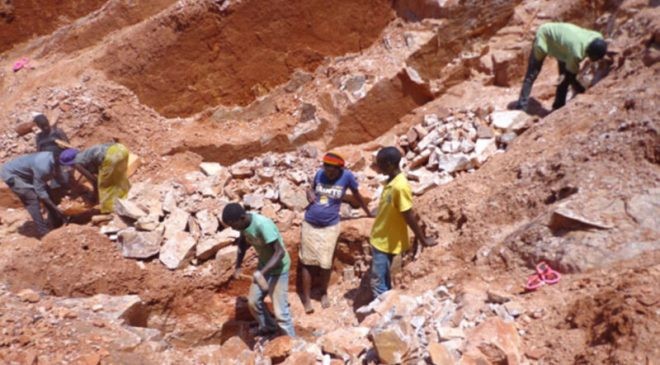By Jean Christian Ihirwe
A Fragile Livelihood with Hidden Dangers
In the heart of Rwanda’s Central Province, Muhanga District is known for its rolling hills and fertile farmlands. But beneath this natural beauty lies a growing threat: illegal stone quarrying, which, while providing livelihoods for hundreds, is slowly eroding both human health and the environment — and deepening the climate crisis.
Driven by the country’s construction boom, informal quarry operations have multiplied rapidly. According to the Rwanda Mines, Petroleum, and Gas Board (RMB), over 60% of small-scale quarries in Muhanga operate without licenses or environmental safeguards. Local officials estimate more than 30 unregulated sites, most lacking dust control systems, protective gear, or rehabilitation plans.
What began as a way to earn daily income has become a slow-moving disaster — one that affects not just the workers but entire ecosystems that sustain local agriculture.
Choking Dust, Scarred Lungs
The human toll is visible.
Nduwamungu, a 36-year-old father of three, has spent years in the quarries.
“I started to feed my family,” he says, “but I didn’t realize the toll it would take on my body. The dust suffocates me. Over time, I developed severe breathing problems.”
He is one of many. Muhanga District Hospital report recorded a 27% rise in respiratory illnesses over the past three years, a trend local health officials directly link to quarry dust exposure.
Ruterana, 42, who has worked in the quarries for over a decade, says the work has left lasting scars:
“My chest feels heavy all the time. I have a persistent cough. Doctors say it’s from inhaling dust day after day. Many of us are sick, but we have no other work.” These voices reveal an unseen epidemic — a public health crisis intertwined with poverty and environmental degradation.
When Dust Enters Homes and Fields
The danger extends far beyond the quarry walls. Fine dust drifts into nearby villages, coating crops, contaminating water sources, and making the air unbreathable.
Nurse Janviere Mukandayisenga from Kabgayi Hospital warns that children are particularly at risk:
“We see many patients from quarrying communities suffering from persistent respiratory infections. Some are young children whose lungs are still developing, making them more vulnerable.”
A Rwanda Biomedical Center (RBC) 2024 study found that respiratory illnesses linked to quarry dust exposure have risen by about 15% in mining districts, including Muhanga.
But beyond lungs, the dust also affects livelihoods. When it settles on bean, maize, and cassava fields, it reduces soil fertility, clogs irrigation channels, and lowers crop yields. For many smallholder farmers who rely on rain-fed agriculture, this adds another layer of vulnerability in a climate already growing hotter and drier.
The Environmental Price: Climate at Risk
Illegal quarrying leaves deep scars on the land — accelerating soil erosion, deforestation, and biodiversity loss. Hills once covered with green are now stripped bare, worsening carbon loss and reducing the land’s capacity to absorb rainfall.
Abandoned quarry pits collect stagnant water, becoming breeding grounds for mosquitoes and waterborne diseases. Nearby rivers, silted and polluted by runoff, threaten both human and livestock health.
Environmental experts warn that such degradation also intensifies local climate impacts — from rising surface temperatures to more erratic rainfall patterns that disrupt nearby farms. In essence, quarrying for stone today may be quietly undoing decades of work to build climate resilience in Rwanda’s agricultural heartland.
Government Response and the Road Ahead
Francis Kamanzi, CEO of the Rwanda Mines, Petroleum, and Gas Board, acknowledges the scale of the challenge: “The government has put in place regulations to ensure safety in mining and quarrying. However, illegal quarrying remains a problem because it is hard to monitor and control. We encourage people to engage in licensed operations that prioritize worker safety and environmental protection.” Authorities have increased inspections, distributed protective gear in legal sites, and launched awareness campaigns. Yet, without alternative livelihoods or sustainable quarrying models, many workers remain trapped in a cycle of exploitation.
A Call for Sustainable Solutions
To protect both people and planet, solutions must go beyond enforcement. Local cooperatives and youth groups could be trained in sustainable quarrying and land restoration techniques, replanting trees and stabilizing soil around former pits.
Development partners and district leaders can also help integrate climate-smart agriculture for families who rely on quarrying — offering new income sources such as beekeeping, agroforestry, or eco-brick making. As Rwanda strives toward its Vision 2050 and climate-resilient development goals, Muhanga’s story is a powerful reminder: fighting climate change is not only about reducing carbon; it is about protecting people’s right to breathe clean air, grow healthy food, and live on thriving land.


